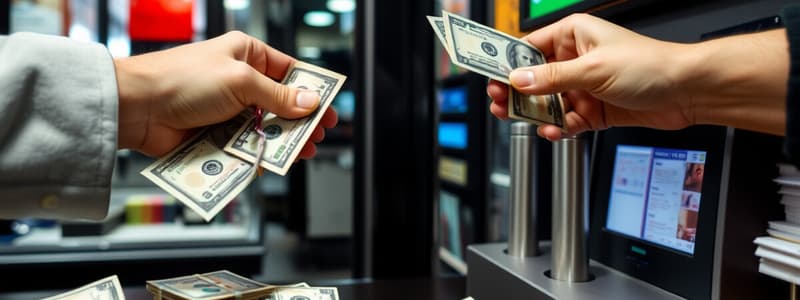Podcast
Questions and Answers
What happens in Transfer Mode when a Bank Account transaction occurs between two different banks?
What happens in Transfer Mode when a Bank Account transaction occurs between two different banks?
- Both banks cancel the transaction.
- The accepting bank assumes the liability and exchanges assets. (correct)
- The initiating bank assumes the liability.
- Only one bank cancels the transaction
When does a Bank Account enter Redemption Mode?
When does a Bank Account enter Redemption Mode?
- When balances are used to repay loans. (correct)
- When a transfer between banks occurs.
- When new money is deposited.
- When notes and coins are deposited.
Which type of money is replaced due to wear and does not have a Redemption Mode?
Which type of money is replaced due to wear and does not have a Redemption Mode?
- Central Bank Account.
- Electronic transfers.
- Bank Account.
- Notes & Coins. (correct)
Who issues money in Issuance Mode for Notes and Coins?
Who issues money in Issuance Mode for Notes and Coins?
What is a key feature of a Bank Account in Transfer Mode?
What is a key feature of a Bank Account in Transfer Mode?
Which mode creates balances by an issuing entity?
Which mode creates balances by an issuing entity?
In what mode do balances move between holders?
In what mode do balances move between holders?
Which money type is created when a Bank extends a Loan?
Which money type is created when a Bank extends a Loan?
What is the primary function of Redemption Mode in relation to Central Bank Accounts?
What is the primary function of Redemption Mode in relation to Central Bank Accounts?
How are Central Bank Accounts similar to Notes & Coins?
How are Central Bank Accounts similar to Notes & Coins?
Which entity is allowed to hold balances in Central Bank Accounts?
Which entity is allowed to hold balances in Central Bank Accounts?
Contrary to popular belief, how do Banks lend money?
Contrary to popular belief, how do Banks lend money?
What occurs in Transfer Mode when the accounts involved are from different banks?
What occurs in Transfer Mode when the accounts involved are from different banks?
Which characteristic distinguishes Notes & Coins from Bank Accounts?
Which characteristic distinguishes Notes & Coins from Bank Accounts?
In what manner are balances transferred between public holders in Bank Accounts?
In what manner are balances transferred between public holders in Bank Accounts?
Which of the following describes a feature of Issuance Mode?
Which of the following describes a feature of Issuance Mode?
What happens to Central Bank Account balances in Redemption Mode?
What happens to Central Bank Account balances in Redemption Mode?
How does the transfer of balances in Bank Accounts primarily occur?
How does the transfer of balances in Bank Accounts primarily occur?
What is the relationship between Notes & Coins and Central Bank Accounts?
What is the relationship between Notes & Coins and Central Bank Accounts?
In which scenario can banks use their Central Bank Account balances?
In which scenario can banks use their Central Bank Account balances?
What is a key characteristic of the Bank Accounts considered in Issuance Mode?
What is a key characteristic of the Bank Accounts considered in Issuance Mode?
What does the term 'Transfer Mode' imply about a money type?
What does the term 'Transfer Mode' imply about a money type?
Why do Bank Accounts not strictly rely on the money from deposits?
Why do Bank Accounts not strictly rely on the money from deposits?
Flashcards are hidden until you start studying
Study Notes
Modes of Transaction for Money
- Three modes of transaction exist: Issuance Mode, Transfer Mode, and Redemption Mode.
- Issuance Mode: Balances created by an issuing entity.
- Transfer Mode: Balances reallocated between holders.
- Redemption Mode: Balances extinguished by the issuing entity.
Types of Money
-
Notes & Coins:
- Originates from Issuance Mode via Central Bank printing press.
- Circulates in Transfer Mode between holders.
- No longer operates in Redemption Mode since the Gold Standard was abandoned.
-
Central Bank Accounts:
- Act as a “bank account for banks,” created in Issuance Mode.
- Electronic equivalent of Notes & Coins, held only by banks.
- Balances recorded in a ledger managed by the Central Bank.
- Transfers occur between banks to balance retail banking system flows.
- Banks can redeem balances for physical Notes & Coins or use them to buy assets like Government Bonds, extinguishing that portion.
-
Bank Accounts:
- Created when banks extend loans to clients, representing Issuance Mode.
- Primarily operates in Transfer Mode, moving between public Bank Accounts recorded in individual ledgers.
- Balances can be acquired through:
- Entering a Loan Agreement resulting in a credited amount.
- Transactions from other bank accounts, with liability adjustments based on servicing banks.
- Rare deposits of physical Notes & Coins.
- Redemption Mode occurs when balances are used to repay loans, extinguishing both the Money and the Loan.
Overview of Transaction Modes
-
Notes & Coins:
- Issued by Central Bank.
- No Redemption Mode available (maximum wear limits).
-
Central Bank Accounts:
- Issued by Central Bank to banks for asset purchases.
- Operate exclusively between banks in their Central Bank ledger.
- Redemption is possible at Central Banks.
-
Bank Accounts:
- Issued by banks to the public for loans.
- Transactions occur within banks’ ledgers.
- Redemption occurs upon loan repayment by the public.
Clarification of Concepts
- Understanding these concepts is facilitated through practical examples.
- Each type of money interacts uniquely within its assigned transaction modes, influencing the banking and financial systems.
Modes of Transaction for Money
- Three modes of transaction exist: Issuance Mode, Transfer Mode, and Redemption Mode.
- Issuance Mode: Balances created by an issuing entity.
- Transfer Mode: Balances reallocated between holders.
- Redemption Mode: Balances extinguished by the issuing entity.
Types of Money
-
Notes & Coins:
- Originates from Issuance Mode via Central Bank printing press.
- Circulates in Transfer Mode between holders.
- No longer operates in Redemption Mode since the Gold Standard was abandoned.
-
Central Bank Accounts:
- Act as a “bank account for banks,” created in Issuance Mode.
- Electronic equivalent of Notes & Coins, held only by banks.
- Balances recorded in a ledger managed by the Central Bank.
- Transfers occur between banks to balance retail banking system flows.
- Banks can redeem balances for physical Notes & Coins or use them to buy assets like Government Bonds, extinguishing that portion.
-
Bank Accounts:
- Created when banks extend loans to clients, representing Issuance Mode.
- Primarily operates in Transfer Mode, moving between public Bank Accounts recorded in individual ledgers.
- Balances can be acquired through:
- Entering a Loan Agreement resulting in a credited amount.
- Transactions from other bank accounts, with liability adjustments based on servicing banks.
- Rare deposits of physical Notes & Coins.
- Redemption Mode occurs when balances are used to repay loans, extinguishing both the Money and the Loan.
Overview of Transaction Modes
-
Notes & Coins:
- Issued by Central Bank.
- No Redemption Mode available (maximum wear limits).
-
Central Bank Accounts:
- Issued by Central Bank to banks for asset purchases.
- Operate exclusively between banks in their Central Bank ledger.
- Redemption is possible at Central Banks.
-
Bank Accounts:
- Issued by banks to the public for loans.
- Transactions occur within banks’ ledgers.
- Redemption occurs upon loan repayment by the public.
Clarification of Concepts
- Understanding these concepts is facilitated through practical examples.
- Each type of money interacts uniquely within its assigned transaction modes, influencing the banking and financial systems.
Studying That Suits You
Use AI to generate personalized quizzes and flashcards to suit your learning preferences.




